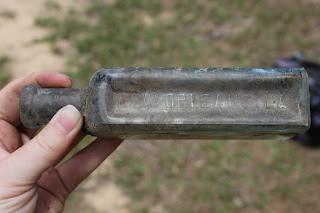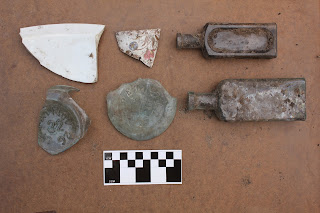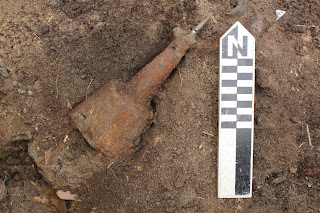This week was a short week due to the 4th of July but boy, did we make the most of it! With the cooler weather this week and awesome data we collected, this week was a dream come true!
If you'll remember last week, we were working on a refuse pit feature in Unit 150, on the private property adjacent to the Simpson property. We had ended the week with us uncovering a large iron concentration in the south half of Unit 150, which we called Section D of Feature 504. This week we dove right in on Unit 150, removing the majority of the iron concentration on Tuesday after spending Monday documenting the extent of this new feature section. The removal of this feature was a delicate procedure because iron artifacts exist in a state of equilibrium underground but become very fragile once exposed or disturbed. We documented each recognizable iron artifact before removal because of the real possibility that the artifact would not make it back to the lab for processing and conservation.When the iron artifacts were removed, many unfortunately did crumble into many indeterminate small iron fragments, due to extended exposure to moisture and air. However, due to our diligence, we have photographic documentation and some diagnostic features have been preserved, such as the two decorative handles adorning the pail.
 |
| In Unit 150, undergraduate Robert Cornforth and graduate student Supervisor Dani Mount are excavating around the iron pail in order to remove it . |
 |
| A close-up picture of the iron pail before its removal. Notice the fragile edges that have already begun to crumble. |
This feature section has been rich in diagnostic artifacts, which means they have distinct features or characteristics that can help us date when these depositional episodes occurred and who could have possibly placed them there. Besides the many iron cans of various sizes and shapes, there were many bottles, of both clear and amber glass. One of the exciting finds was a clear early molded glass bottle with a complete maker's mark on the base, which we confirmed as belonging to a company that only manufactured these types of bottles with that maker's mark between the years of 1875 and 1878!
 |
| The first bottle of many, from Feature 504 Section D with a complete maker's mark. |
By Wednesday, we had removed Feature 504 section D and now had the fullest extent of Feature 504 section A! This dark brown feature was characterized by large burned oyster shells and large quantities of carbonized wood when it was first uncovered in the north wall of Unit 150. While these were still present in the feature fill, large quantities of mostly complete glass bottles appeared. Many of these bottles were of the early molded variety, missing the sucker scar of modern machine-made glass bottles but did not have any of the characteristics of hand-blown or free-blown bottles, such as puddling at the base and pontil scars.
The most exciting of the bottles is a bottle that has embossing on both sides. One side says L.L.Lyons & Co. and the other says New Orleans, LA. This was a bottle whose contents were manufactured or sold by a pharmacist between 1880 and 1900, in New Orleans.
 |
| Here is the bottle, the embossing says L.L.Lyons & Co. |
 |
| And the opposite side of this bottle says New Orleans, LA. |
The rim and base of a brown-transfer printed hand-collected porcelain teacup and the rim of a plain molded porcelain bowl were also collected from this feature, more firmly placing the date of the feature in the late 1800's.
 |
| Here is an example of the artifacts from Feature 504 section A. The two ceramics in the upper left are porcelain, while all the bottles are clear or soda lime molded glass bottles. |
As we were diligently working on excavating Feature 504 section A, our landowners came out to visit with us and were present when we removed what appears to be a iron oil lamp from Feature 504 section A. They were just as excited as we were! When we first uncovered the neck of the oil lamp, it appeared like a whistle, a small bore cylinder with a silver colored tip and a notch for air, but as it was uncovered, that seemed more and more unlikely. When it was fully uncovered, it was obviously not a whistle. What we had was a lead-lined oil lamp, with an octagonal base and decorations on the neck and base. Underneath this extraordinary find, we found a small triangular iron container with a brass medallion affixed to the bottom. This brass medallion has an soaring eagle with a shield and arrows in its talons, surrounded by The Charles Parker Co., Meridian.
 |
| Before removing the oil lamp from the feature, we took many pictures, just in case. |
AND on the other side of the Simpson property, in the remains of the main house, early in the week we found the wood floor of the basement of the main house in three units! The rest of the week was spent documenting through maps and photographs to complete Units 152, 153 and 155!
 |
| Units 153 and 155 with Feature 501, a pair of remnant brick piers and curtain wall, and Feature 462 section D and E, the brick floor and Feature 461 Section D, the burned wood floor. |
 |
| Unit 152, with Feature 500, a remnant brick pier now wall, Feature 461 E, the burned wood floor of the basement and Feature 462 F, the brick floor underneath the wood floor! |
We also opened an extension off Units 138, 154, 156, and 157. This extension was decided on because we had been chasing Feature 472, what we had interpreted as the south wall of the basement, however as we continued to excavate segments of the wall, the corner we had been hoping was found, but instead of turning north as expected, it turned SOUTH! We're still working on uncovering the wall as it extends into this new unit, Unit 158, so stay tuned for more updates this week!!

No comments:
Post a Comment